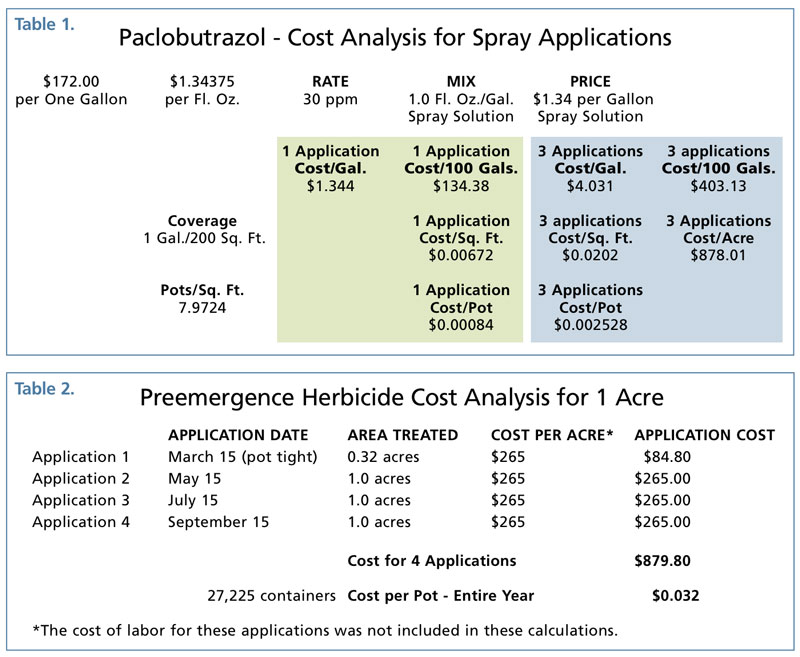6/1/2021
Knowing the True Costs of Your Applications
Paul Pilon

Let’s face it—nobody likes to overpay for anything. This applies to our personal lives and how we run our businesses. Behind every purchase there has to be value, at least a perceived value. When we buy a product, we want the confidence of knowing that we’re going to receive something in return. In many instances, pricing can seem expensive and it may be hard to determine if you’re getting what you paid for.
Over the years, I’ve heard many comments from growers on how expensive plant growth regulators, insecticides or herbicides are. In some cases, there’s definitely sticker shock when looking only at the price per package, jug or bag. However, it’s important to look at the cost per application, as well as the cost per plant and the significance of the benefits received when evaluating the value these products offer before jumping to conclusions.
To demonstrate the value proposition between raw price and the benefits certain products offer, I’d like to briefly walk through two mock case studies.
Case Study A: PGRs
A grower recently purchased 1 gallon of paclobutrazol concentrate for $172.00. This grower typically applies three 30 ppm paclobutrazol spray applications to their 1-qt. perennial program, which is grown pot-to-pot. Let’s look over the costs of this grower’s applications (labor is not included) in Table 1.
I can see how the price of $172.00 for the paclobutrazol and the cost of $878.01 per acre for three PGR applications may seem like a hefty production expense. However, when looking at the cost per pot, it’s a lot more palatable. In this example, with 1-qt. containers grown pot-to-pot, the cost per container is only $0.0025 or one cent for every four containers.
 Now let’s look at the value PGRs provide. By producing smaller plants, growers can fit more plants on their shipping carts. What if instead of shipping racks with four shelves full of plants they can now accommodate five shelves? That’s 25% more plants per shipping cart, which greatly increases the shipping efficiencies while decreasing shipping costs.
Now let’s look at the value PGRs provide. By producing smaller plants, growers can fit more plants on their shipping carts. What if instead of shipping racks with four shelves full of plants they can now accommodate five shelves? That’s 25% more plants per shipping cart, which greatly increases the shipping efficiencies while decreasing shipping costs.
The ability to manage plant size using PGRs also allows growers to grow plants at tighter spacings. I’ve seen growers produce anywhere from 25% to 108% more plants per square foot when utilizing PGRs during the production cycle. With more plants per square foot, growers can not only increase their sales revenue per square foot, they can also produce more plants to sell.
There are other value-added benefits PGRs provide. Plants treated with PGRs have a longer shelf life allowing them to maintain their quality for seven to 14 days longer than untreated ones. This is especially valuable when cold, wet weekends occur during the spring sales season. With a longer shelf life, growers can hold plants in the greenhouses when adverse conditions arise and the plants will maintain their quality longer in retail settings.
As these examples demonstrate, the benefits of using PGRs can significantly offset the price of these applications. I’m not an accountant, but if you ask me, it sure sounds like the cost savings and benefits received by far exceed the $0.0025 per pot spent on three PGR spray applications.
Case Study B: Herbicides
A grower is looking to making a granular herbicide application over the top of 2-gallon-sized containers of shrubs throughout the growing season. The plants are currently grouped together in a pot-to-pot configuration and will be spaced after the first herbicide is applied and watered in.
The preemergence herbicide cost is $132.50 per 50-lb. bag and the application rate is 100 lbs. or two bags per acre. Therefore, the application cost is $265.00 per acre (not including labor). Does $132.50 per bag, or $265.00 per acre, sound expensive? Let’s see how the numbers work out.
Prior to the first application, 27,225 two-gallon containers are grouped pot-tight, occupying 12,100 sq. ft. (0.278 acres). Since it’s nearly impossible to broadcast herbicides and only have the granules land inside the pots, let’s add 15% more to the area being treated; this results in 0.32 acres and a cost of $84.80 for the initial application. With 27,225 pots being treated in this area, the cost per pot for this first application is $0.0031.
Most preemergence herbicides will provide two to three months of control. Let’s assume the herbicide needs to be applied at two-month intervals to maintain adequate weed control and it will require three additional applications during the growing season.
Following the initial application, the plants were spaced at 1.6 sq. ft. per pot to occupy 1 acre of production area after spacing (still 27,225 two-gallon pots). At the final spacing, the cost is $265.00 per acre per application. Table 2 shows the costs for the entire season (four applications) when applying 100 lbs. per acre over 27,225 two-gallon containers.
I’m with you—initially $879.80 per acre to make herbicide applications for the year seems crazy. However, season-long weed control utilizing four applications at a total cost of 3.2 cents per pot doesn’t sound nearly as bad. I can see how treating tens or even hundreds of thousands of containers can really add up. Before falling off your chair or shocking your accounts payable department, be sure to look at the value and cost savings preemergence herbicide applications can provide.
According to Dr. Joe Neal, Professor of Weed Science at North Carolina State University, if a grower relied exclusively on hand weeding, the costs would be about $4,200.00 per acre per year (assuming eight months of hand weeding during the growing season and four months of negligible hand weeding over the winter months). When an effective herbicide program is used, hand weeding costs are reduced to $1,174.00 per acre per year (72% less than hand weeding alone).
As Dr. Neal implied, some hand weeding will still be necessary even when using a preemergence herbicide program. Hand weeding should be done at least every four weeks, but is particularly important before each preemergence herbicide application to ensure a clean, weed-free start. For the sake of this conversation, let’s assume hand weeding will be reduced by 70% when herbicides are being used.
Now let’s look at some more calculations in Table 3.
In Table 3, I looked at costs and savings between hand weeding only and when using the preemergence herbicide program. In this example, I kept the same number of pots per acre, number of applications and the herbicide costs used throughout this discussion. I also kept with the numbers Dr. Neal provided—the cost of hand weeding only for 1 acre is $4,200.00, and when using a preemergence herbicide program, hand weeding is reduced by 70%.
 As the table demonstrates, the cost of hand weeding combined with the four herbicide applications is $2,439.80. Using preemergence herbicides would provide a cost savings of $1,760.20 or $0.0647 per
As the table demonstrates, the cost of hand weeding combined with the four herbicide applications is $2,439.80. Using preemergence herbicides would provide a cost savings of $1,760.20 or $0.0647 per
2-gallon container over the anticipated costs of only hand weeding. This is a 41.9% reduction in weed management costs.
Looking at these calculations, it’s very clear there’s a huge financial advantage or savings obtained when using preemergence herbicides compared to only hand weeding. Who couldn’t justify spending (investing) $879.80 for herbicides to cut weed management costs by $1,760.20? The total savings obtained are twice as much as the cost of preemergence herbicide. This has a better annual return on investment than you can obtain in the stock market.
With reduced weed pressure, the majority of the savings are obtained through the reduction of labor costs. This is huge as the cost of labor continues to rise while the availability of labor continues to decline. Several growers can’t even find enough labor to keep up with hand weeding.
Weeds also say a lot regarding a grower’s production practices and negatively affect perceived plant quality. They’re great sources of insect pests, mites, pathogens and viruses, not to mention the source of more weeds that lead to additional costs to control these issues. There also are studies showing that weeds take nutrients away from crops, resulting in less growth, reduced quality and increased fertility costs. The bottom line is weeds are costly in many ways. I can’t deny there’s a cost to using preemergence herbicides, but as I’ve demonstrated above, it likely costs much more not to use them.
Take-home message
To wrap this up, I hope these case studies effectively demonstrate that the use of PGRs and preemergence herbicides actually provide a significant cost savings, along with the other benefits they provide. I hope I effectively provided you with a different perspective that these products offer a significant savings that far exceed the price paid of using these products, whether on a large or small scale.
I encourage you to look beyond the price per jug or bag of product and to perform your own calculations to determine not just what your applications costs will be, but to realize how significant the benefits and cost savings are. Then ask yourself, “How much is it costing me to not use PGRs or preemergence herbicides?” GT
Paul Pilon is a Technical Manager at OHP, Inc. and editor-at-large of the Perennial Pulse e-newsletter. Feel free to contact him with article topics or to address your production challenges. He can be reached at ppilon@ohp.com.